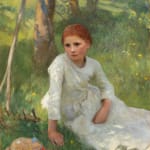George Clausen 1852-1944
Framed: 150 x 118 cm.; 59 x 46½ in.
In 1897 Clausen gave a small oil sketch to his friend, the sculptor, William Goscombe John, Girl in a Field, (National Museum of Wales, Cardiff). Painted around seven years earlier, the sketch was part of the elaborate planning procedure for a major work abandoned at the time, but now being revisited. The circumstances surrounding this act of generosity remain obscure, but the little picture itself is not insignificant. It shows a girl with red hair, sitting under a tree. The full sunlight strikes her white dress. Swift, slashing strokes of paint indicate that this figure study was blocked in very quickly – but then, the artist knew exactly what he was doing as he worked towards the realization of Noon in the Hayfield, the major canvas he had temporarily put aside back in 1891.
Some of Clausen’s earliest preoccupations are reflected in the work. These stretch back to 1880 when, in his late twenties, he stood in front of Bastien- Lepage’s Les Foins, (Musée d’Orsay, Paris), the great picture of resting haymakers, then on show at the Grosvenor Gallery. It, as much as anything, prompted his move to the country the following year, and by 1883 his own version of the subject, Day Dreams, (private collection) was exhibited at the Institute for Painters in Oil Colours in London. Here, two women, young and old, are resting in the shade, while nearby, a young mower pauses and realizes that it is time to lay down his rake. By 1886, when he painted A Midsummer Day (private collection), Clausen had witnessed such moments of reverie on many occasions.
By 1890, sketchbook studies in pencil, at least one pastel and the Goscombe John oil, indicate that he was reworking the same pose using a younger model, Rose Grimsdale. But what did this mean? Was the content – a haymaker’s rest – a given, and technical advance the true priority? Was this innocent idleness, a moment’s respite from relentless toil, or an experiment in new techniques? As Clausen returned to apply the finishing touches to Noon in the Hayfield, in 1897, the work that had been in gestation for over a decade, would all become clear?
Clausen left London in 1881 at a time of great unrest in the countryside when labouring families, like that of his model, had been drifting to the burgeoning industrial centres for several generations. A crisis was fast approaching. The country was no longer self- sustaining in food production. For many landowners, the situation was exacerbated by tighter regulation that affected the employment of children at key points in the farmer’s year. While the Education Act of 1880 demanded compulsory school attendance for all children up to the age of ten, it was not unusual for classrooms to be empty during the month of June when ‘haysel’ – the hay harvest – occurred. This required boys and girls to follow the mowers, their job simply to rake the fallen grass into ‘haywakes’ to aid the drying process This was labour-intensive. On small holdings, where fruit trees were often planted at the edge of a meadow, the use of new-fangled machinery was impossible.
Around 1890 Clausen’s sketchbooks record men scything, rick-building and tending livestock. Implied narratives of youth and age or secret trysts are excluded as his young fieldworker is placed at the edge of the meadow. Sketchbook studies of Rose are drawn and redrawn in reverse. And while we can vouch for the accuracy of Clausen’s observation, by the late nineties it had become clear that he and his French and British contemporaries were not so much recording an occupation as bolstering a threatened way of life. It was this powerful sense of a stable society under threat that kept the image of the country girl in focus as plein air painting moved ever closer to Impressionism. The planning for what would become Noon in the Hayfield had started in earnest and the resting fieldworker was redrawn in outline on a larger scale with trees and haywakes in the background, almost as a cartoon (Study for ‘Noon in the Hayfield’, c. 1890, Royal Academy of Arts, London).
By 1891 an exhibition-piece watercolour was nearing completion, when Clausen’s circumstances changed. Early in the year it became apparent that his lease on Grove House, Cookham Dean was coming to an end and he would have to move. With a growing reputation, he also required a larger studio, and the stimulus of a new working environment. The early summer of 1891 was spent house-hunting in the northern reaches of Essex until he hit upon ‘Bishops’ at the village of Widdington, where he moved just before harvest time. At the last minute, the watercolour, Idleness, (private collection) was submitted, ex-catalogue, to the Royal Society of Painters in Watercolours as he set to work exploring the fields and farms of a new landscape. The large painting, later to be known as Noon in the Hayfield, was put on hold.
New subjects – harvesting, ploughing and barn interiors followed – but the contact with his Cookham Dean models, Rose Grimsdale and the Baldwin sisters, was severed. It was only when he started to look again at head studies of Rose in 1896 and had found new girls and boys in Widdington who were willing to pose for him, that the thought of finally finishing the picture returned. He looked again at all the planning he had done and made some changes. The hat, which in Idleness lies behind the girl, was brought into the foreground. The windfalls that lie on the grass in the watercolour, suggesting an orchard in autumn, are removed, and the rake, essential in midsummer mowing is added, as in the outline drawing. Having begun to modify the mechanical ‘square’ brushwork of his early naturalist pictures, Clausen was thinking more about colour. Sundry references in letters indicate that he had been looking critically at the work of Manet, Monet and Degas. The high colour key derived from pastel, reveals the degree to which new attitudes were informing Clausen’s technique in all media. Questions of métier, of how to represent, overtake those connected with what to represent. His previous reference to Rose at this point was the half-length, Brown Eyes, (Tate Britain), held over from Cookham days to be shown in 1892 and when Noon in the Hayfield was finally resumed five years later, Clausen had been elected Associate of the Royal Academy by a popular vote.
Clausen’s long gestation of the resting haymaker had, for all its suave naturalism, resulted in one of his most rigorously taut and deeply pondered compositions. Rest, reverie and the sunlit glow of field and wild flowers combine to produce one of the most satisfying visions of the English countryside at the end of the nineteenth century.
Kenneth McConkey
Provenance
The Artist, to Isaac Smith Esq, JP, Field House, Dausy Hill, Bradford;
His sale, Christie’s, London 15 May 1911, lot 43 (90 gns);
Private Collection, by descent;
Their sale, Sotheby's, New York, 28 February 1990, lot 122
Private Collection, Germany
Sotheby's, London, 23 May 2013, lot 27
Richard Green Gallery, London
Private Collection
Bonhams, London, 27 September, 2017, lot 114
Private Collection
Literature
Kenneth McConkey, George Clausen and the Picture of English Rural Life, Edinburgh, 2012, pp. 122-3 (illustrated in colour)
Kenneth McConkey, George Clausen: The Rustic Image, exhibition catalogue, The Fine Art Society, London, 2012, p. 36




